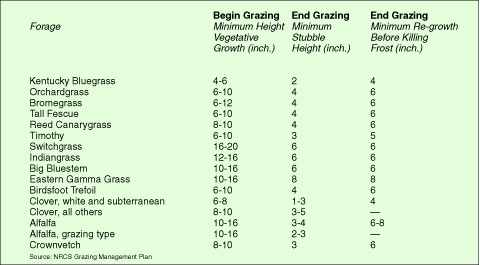When grass is green and abundant, our world as it relates to pasture management is serene. Perfect all the times, wouldn’t it be nice if life could always be that way?
Unfortunately, we will experience drought, excessive mud, severe winters, excessive forage growth, summer slumps, livestock sickness and livestock death. The truly successful grazers have a contingency plan for all of these periods. Let us look at each of these periods and discuss some management options.
Farms will have different management options based on resources and not all options are appropriate for every grazer.
Drought Contingency Plan
Each summer brings slowed forage growth. Temperature, rainfall, grazing management and forage species all influence the extent of forage growth during the summer. One should strive to maintain proper grazing heights throughout the season, especially during dry periods.
The Natural Resource Conservation Service recommends the following minimum grazing heights for forage & legumes (see chart).
The following notes accompany the chart above: 1) Grass and legume mixtures should be grazed in a manner that favors the dominant or desired species.
2) Height is average height when leaves are lifted in vertical position.
3) At end of growing season, minimum re-growth is the critical factor that determines end of grazing except on pastures grazed only in fall and winter. When a grazing period ends, there should be photosynthetic residual remaining adequate to support vigorous re-growth. Less re-growth may be beneficial if frost seeding or inter-seeding will be completed prior to the next grazing season.
4) The last harvest of alfalfa, for pasture or hay land, should be made 35-45 days prior to the time when the first freeze normally occurs.
5) In a rotational grazing system, spring grazing can be initiated when cool season forages have approximately 75 percent of their height as shown above. Livestock will need to be moved more rapidly until they are in a paddock where forage has grown to the desired height.
6) If forages are exceeding the “Begin Grazing” heights consideration should be given to making hay or mowing these paddocks. Grazing height is of utmost importance in terms of reducing plant stress, maintaining forage species diversity/productivity and maximizing livestock dry matter consumption.
Another option to reduce forage needs during a drought is to cull unproductive animals. Reducing the livestock inventory prior to forage shortages helps to extend pasture mass and reduce forage and feed requirements.
Some grazers utilize warm season perennials or summer annuals as a means to provide forage during dry periods. There are many options to choose from here and one must consider which livestock species will be grazed, cost and whether the forage is to be hayed or utilized for silage. Feeding hay and supplementing with feed concentrates can stretch pasture reserves. Feeding hay in a sacrifice paddock or on a heavy-use pad will allow for an extended pasture recovery period while preserving forage mass.
When supplementing forage with grain concentrates, remember grain can increase total dry matter consumption and digestibility of poor quality forage. Carefully consider energy source fiber content and forage quality when selecting concentrates and supplementation strategy.
Mud Contingency Plan
When livestock remain on pasture after excessive rainfall, severe damage can occur. To minimize damage, rotate livestock daily and remove animals to a sacrifice area or heavy-use pad as a last resort.
Winter Contingency Plan
Once all freestanding forage is gone, one must have a plan and an area to feed livestock. The winter-feeding area should have a freeze-proof water source, which is well drained, is away from environmentally sensitive areas, and provides protection from inclement weather. Heavy-use pads make excellent winter-feeding areas.
Excessive Forage Growth Contingency Plan
Excessive spring forage growth can be managed by moving livestock quickly through paddocks topping pasture growth and harvesting excess forage as hay or silage. Another option is to add livestock to the grazing system.
New Arrival Contingency Plan
Sick and newly purchased livestock should not be immediately introduced to breeding animals. It may be wise to have a pasture or location dedicated to the care and monitoring of new arrivals and the sick. Ideally, this area would be isolated with no direct contact to other farm animals. It may be necessary to isolate animals for 30-90 days depending on your veterinarians’ recommendations.
Mortality Contingency Plan
To reduce the potential spread of disease, all livestock producers need an approved plan to deal with normal mortality losses. The three most common means of dealing with livestock mortality are composting, burial and licensed renderer. Grazers using composting must have attended an OSU Extension composting certification program. Master grazers make difficult times seem manageable by following a plan.
The plan is a system that addresses all of the variables that can and will occur when raising livestock. To start your plan, contact Clif Little at the Guernsey County Extension office at 704-489-5300 or a member of the Ohio Integrated forage management Team.













